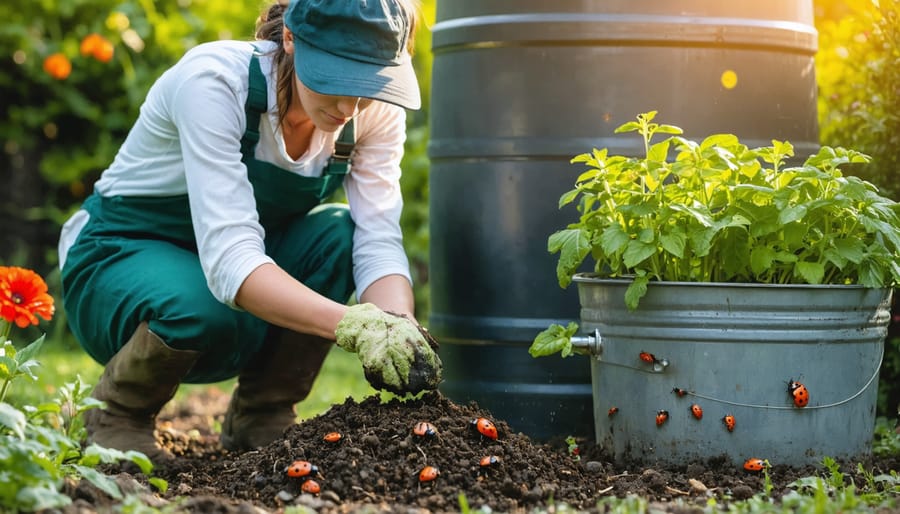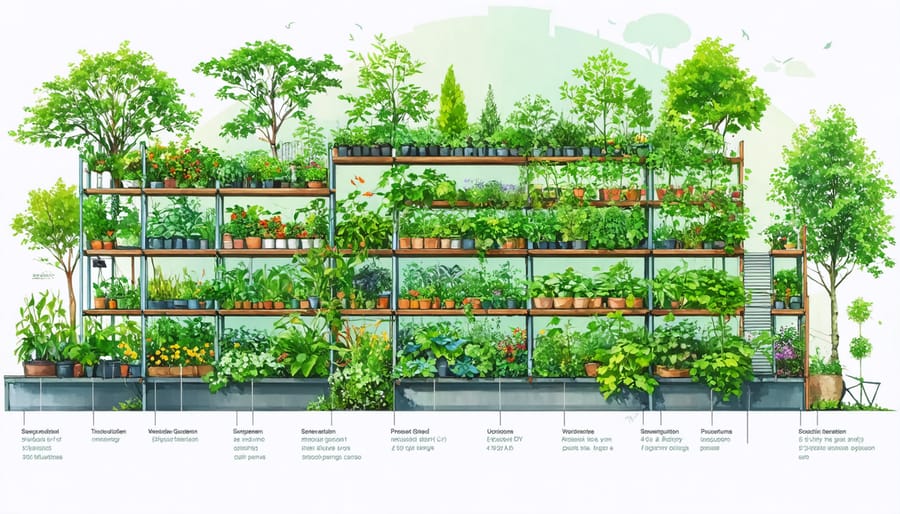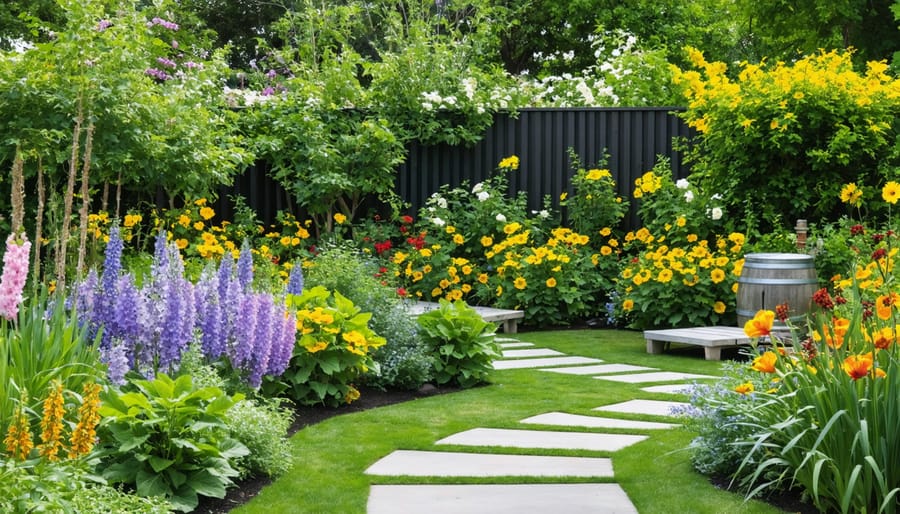Transform your backyard into a thriving food oasis by choosing the perfect vegetable garden style for your space and lifestyle. From space-saving vertical gardens that climb walls to traditional raised beds that optimize soil health, each design approach offers unique advantages for the home gardener. Modern water-saving garden design techniques like keyhole gardens and hugelkultur beds maximize production while minimizing resource use, making sustainable growing accessible to everyone. Whether you’re working with a sunny urban balcony or a sprawling suburban plot, today’s vegetable garden styles blend time-tested wisdom with innovative approaches to create beautiful, productive spaces that nourish both people and planet. Let’s explore how different garden layouts can transform your growing dreams into reality, no matter your experience level or available space.
Raised Bed Gardens: The Perfect Blend of Form and Function
Space-Efficient Grid Layouts
Space-efficient gardening has revolutionized the way we grow vegetables, and square foot gardening leads the pack in maximizing small spaces. This method divides growing areas into 1-foot squares, creating a grid system that eliminates wasted space and makes planning a breeze.
In a typical 4×4 raised bed, you can grow an impressive variety of vegetables by following simple spacing guidelines. Large plants like tomatoes and peppers need one square foot per plant, while smaller crops like radishes can fit 16 plants in the same space. Medium-sized vegetables such as bush beans and leaf lettuce work well with 4-9 plants per square.
The key to successful space-efficient gardening lies in vertical growing techniques. Install trellises along the north side of your beds to support climbing plants like peas and cucumbers, preventing them from shading other crops while maximizing vertical space.
When planning your layout, consider companion planting relationships. For instance, pair tall plants with shallow-rooted vegetables that thrive in partial shade. Plant basil near tomatoes or carrots alongside onions – these combinations not only save space but also promote healthy growth.
Remember to leave narrow pathways between beds for easy access. A 2-foot spacing allows comfortable movement while maintaining a compact garden footprint. This systematic approach to vegetable gardening ensures every inch of your garden works hard to provide a bountiful harvest.
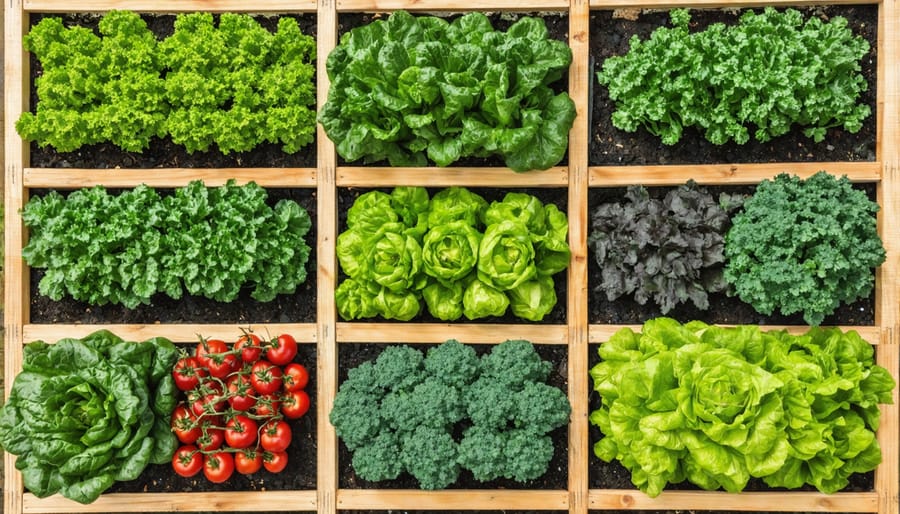
Water-Wise Raised Bed Systems
Efficient water management is essential in raised bed gardening, and modern water-wise systems make it easier than ever to grow thriving vegetables while conserving this precious resource. The key lies in strategic planning and smart irrigation techniques.
Start by incorporating water-retaining materials into your soil mix. Adding organic matter like compost and coconut coir can increase water retention by up to 30%. A layer of mulch on top, whether straw, wood chips, or leaves, further reduces evaporation and keeps soil moisture consistent.
Drip irrigation systems are particularly effective in raised beds, delivering water directly to plant roots while minimizing waste. Install soaker hoses beneath the mulch layer and connect them to a timer for automated watering. This approach uses up to 70% less water than traditional overhead sprinklers.
Consider installing a self-watering reservoir system beneath your raised beds. These systems store water in a chamber below the growing medium, allowing plants to draw moisture up through capillary action as needed. They’re especially helpful during hot summer months and can reduce watering frequency to once a week or less.
For maximum efficiency, group plants with similar water needs together and use moisture meters to monitor soil conditions. Some gardeners even incorporate ollas – unglazed clay pots buried in the soil that slowly release water to surrounding plants, an ancient technique that’s perfectly suited to modern raised bed systems.
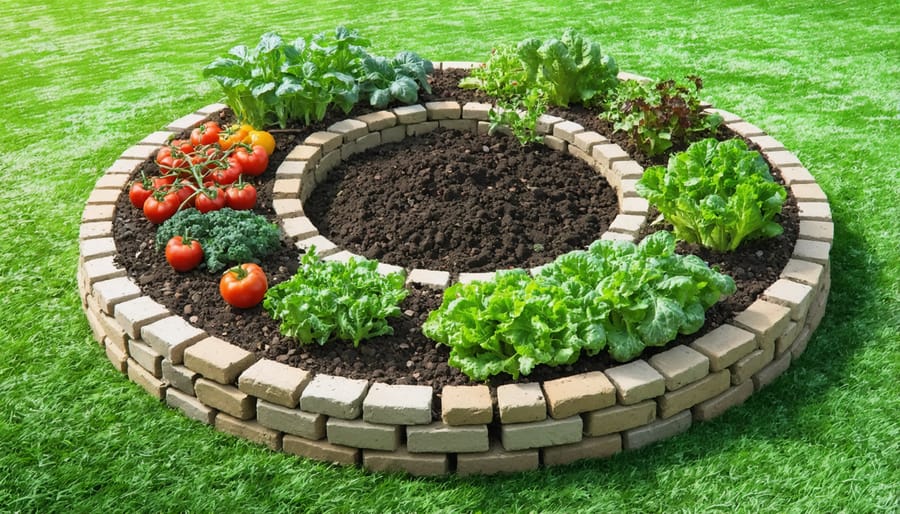
Keyhole Gardens: The Ultimate Water-Saving Design
Building Your First Keyhole Garden
Building a keyhole garden is a rewarding project that combines sustainability with efficient growing space. Start by marking a circular area about 6 feet in diameter, leaving a small notch that creates the distinctive keyhole shape. This notch will serve as your access point to the central composting basket.
Gather materials like stones, bricks, or recycled concrete for the outer walls. Build these walls about 3-4 feet high, laying them in a circular pattern while maintaining the keyhole entrance. In the center, create a composting tower using wire mesh or old fencing material, roughly 1 foot in diameter.
Layer your garden bed with cardboard as a base, followed by twigs, leaves, and straw. Add alternating layers of nitrogen-rich materials (green waste) and carbon-rich materials (brown waste). Top it off with good-quality soil mixed with compost, sloping gently from the center basket toward the edges.
The central composting basket is where you’ll add kitchen scraps and water. As these materials break down, nutrients naturally flow outward to feed your plants, creating a self-sustaining system that’s perfect for growing vegetables with minimal water waste.
Permaculture-Based Vegetable Gardens
Food Forest Integration
Food forests offer an innovative approach to vegetable gardening by mimicking natural forest ecosystems. Through layered food forest design, you can create a self-sustaining garden that combines vegetables with fruit trees, herbs, and beneficial plants.
Start by planning your tallest layer with dwarf fruit trees or larger vegetables like sunflowers. Beneath these, incorporate climbing vegetables such as pole beans or cucumbers on trellises. The next layer down is perfect for bush beans, peppers, and other medium-height vegetables. Ground-level spaces work wonderfully for lettuce, carrots, and other low-growing crops.
Don’t forget to include companion plants like marigolds and nasturtiums, which not only add beauty but also help deter pests naturally. Root crops can occupy the underground layer, while ground covers like strawberries and herbs help suppress weeds and retain soil moisture.
This integrated approach creates a diverse ecosystem where plants support each other’s growth. Your vegetables benefit from improved soil health, natural pest control, and reduced watering needs. Plus, the varied heights and textures create an aesthetically pleasing garden that’s both productive and beautiful throughout the growing season.
Container and Vertical Gardens
Self-Watering Solutions
Self-watering systems have revolutionized container and vertical gardening, making it easier than ever to maintain thriving vegetable gardens with minimal water waste. These clever solutions typically consist of a water reservoir beneath the growing medium, connected by a wicking system that delivers moisture directly to plant roots as needed. Popular options include self-watering containers with built-in reservoirs, which are perfect for busy gardeners or those living in apartments.
For vertical gardens, drip irrigation systems work wonders, delivering precise amounts of water to each plant while preventing excess runoff. Many gardeners are now incorporating smart irrigation controllers that adjust watering schedules based on weather conditions and soil moisture levels. DIY enthusiasts can create their own self-watering planters using simple materials like plastic containers, wicking cord, and PVC pipe.
These water-efficient systems not only save time and resources but also promote healthier plant growth by maintaining consistent moisture levels. They’re particularly effective for thirsty vegetables like tomatoes and cucumbers, which benefit from steady water supply.
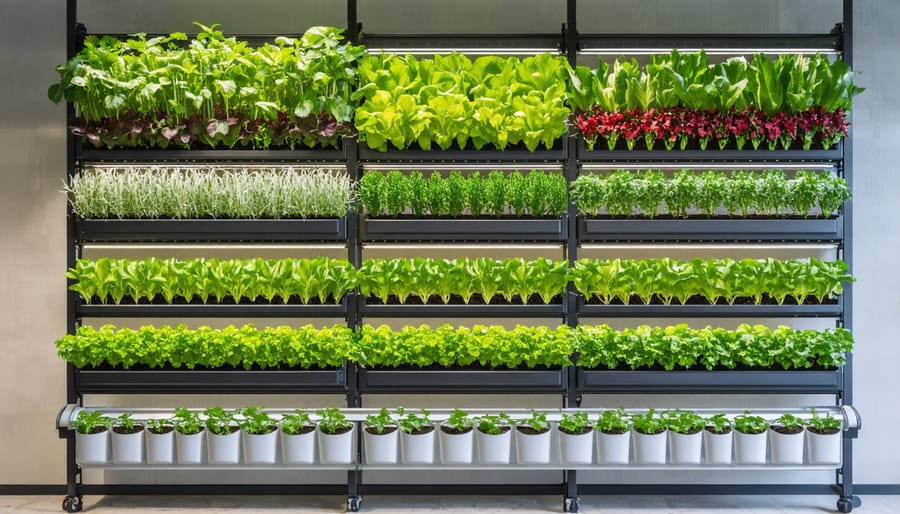
As we’ve explored, there’s a vegetable garden style to suit every space, skill level, and lifestyle. Whether you’re drawn to the space-saving efficiency of vertical gardens, the traditional charm of raised beds, or the permaculture principles of food forests, the key is choosing a style that aligns with your goals and resources. Remember that sustainable practices can be incorporated into any garden style – from water-wise irrigation systems to companion planting and natural pest control methods.
Don’t be afraid to mix and match elements from different styles or start small and gradually expand your garden. The most successful gardens are those that work with your available time, space, and local climate conditions. Consider factors like maintenance requirements, water availability, and seasonal changes when making your choice.
As you embark on your vegetable gardening journey, focus on creating a space that brings you joy while contributing to a more sustainable future. With proper planning and care, your garden will not only provide fresh, healthy produce but also become a thriving ecosystem that benefits both you and the environment.


